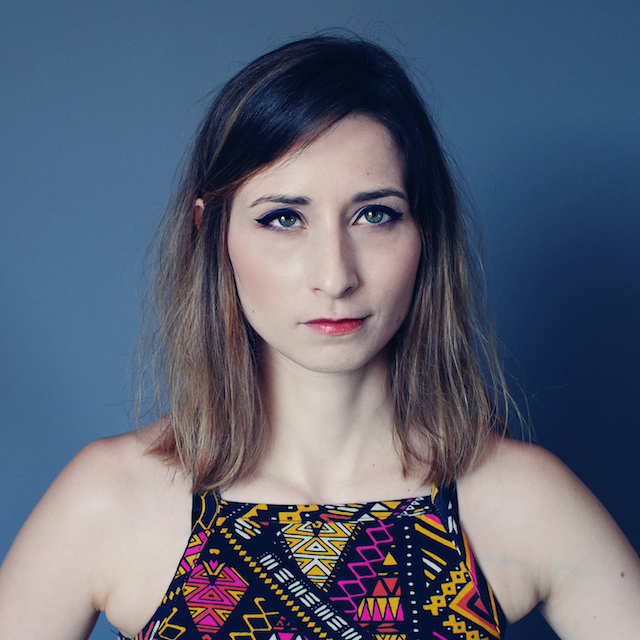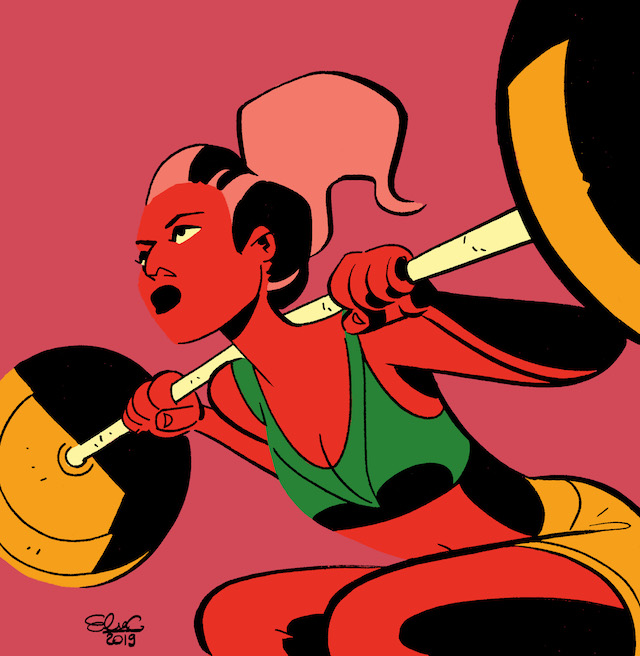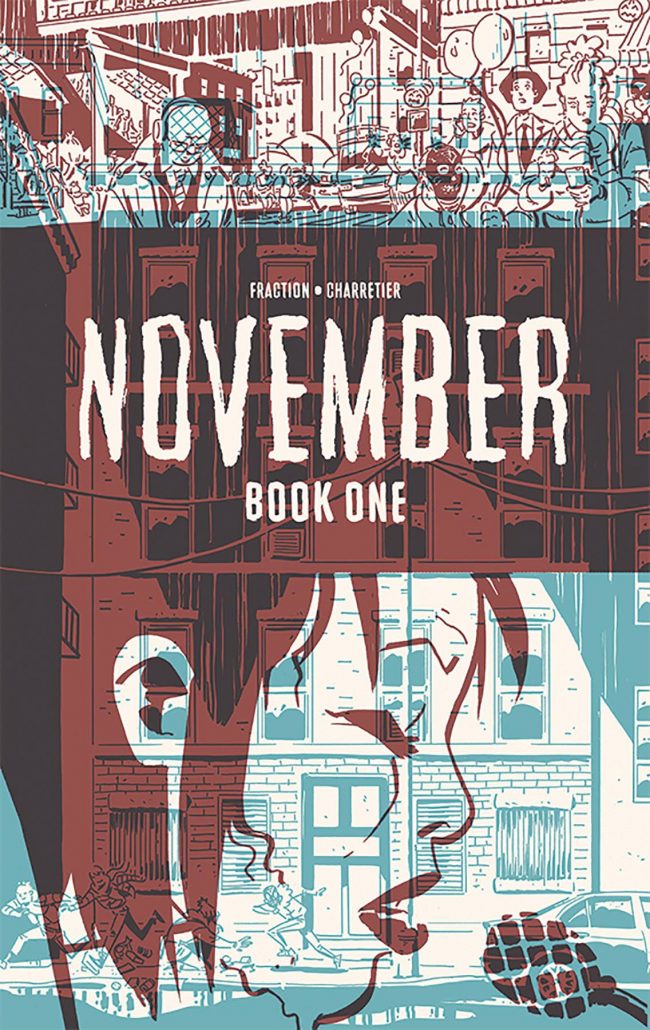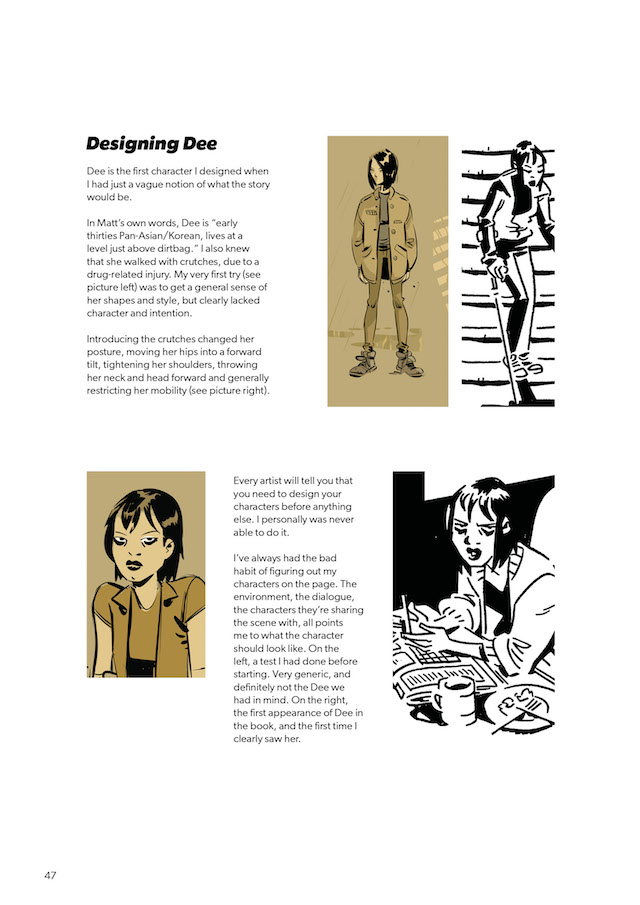 It's easy to take the internet for granted these days. But then, completely by chance, you’ll come across something wonderful, as when a retweet showed me Elsa Charretier’s Batgirl 66 sketch, causing you to sit up and take notice. However, French feminist artist Charretier herself is very aware and appreciative of just how beneficial technology is to the comics community as the Kickstarter for her new art book funded in just five hours. The campaign has ended but the book is now for sale in Charretier’s Etsy store. Charretier and boyfriend Pierrick Colinet got their start in comics crowdfunding their first co-created venture, The Infinite Loop, later published by IDW. The two now run the art studio Big Head Little Arms, the name a nod to their love of Jurassic Park, also referenced in the first pages of The Infinite Loop. Charretier has gone on to work on Star Wars comics, Harley Quinn, and the graphic novel of George R.R. Martin’s Windhaven, amongst others. Last month her collaboration with Matt Fraction, November, hit the shelves. A mystery that leads you in through carefully laid out steps, the art attracts as the writing intrigues. As we’re still waiting to see how these various lives intersect, Charretier deftly shows us their worlds with meaningful subtlety. As part of her Kickstarter, she produced a commentary edition of November, giving further insight into her working process. Over Skype, we spoke of her chance initiation into comics and other such fortuitous events, working with Fraction, her hope for equality in comics, and her love of movies and design.
It's easy to take the internet for granted these days. But then, completely by chance, you’ll come across something wonderful, as when a retweet showed me Elsa Charretier’s Batgirl 66 sketch, causing you to sit up and take notice. However, French feminist artist Charretier herself is very aware and appreciative of just how beneficial technology is to the comics community as the Kickstarter for her new art book funded in just five hours. The campaign has ended but the book is now for sale in Charretier’s Etsy store. Charretier and boyfriend Pierrick Colinet got their start in comics crowdfunding their first co-created venture, The Infinite Loop, later published by IDW. The two now run the art studio Big Head Little Arms, the name a nod to their love of Jurassic Park, also referenced in the first pages of The Infinite Loop. Charretier has gone on to work on Star Wars comics, Harley Quinn, and the graphic novel of George R.R. Martin’s Windhaven, amongst others. Last month her collaboration with Matt Fraction, November, hit the shelves. A mystery that leads you in through carefully laid out steps, the art attracts as the writing intrigues. As we’re still waiting to see how these various lives intersect, Charretier deftly shows us their worlds with meaningful subtlety. As part of her Kickstarter, she produced a commentary edition of November, giving further insight into her working process. Over Skype, we spoke of her chance initiation into comics and other such fortuitous events, working with Fraction, her hope for equality in comics, and her love of movies and design.
AUG STONE: Tell me when you first fell in love with drawing.
ELSA CHARRETIER: I drew a little bit as a kid, like most kids do. But by the time you’re a teenager you forget the things you used to love as a kid. So I stopped drawing for a long time. How I got back into drawing is a funny story. I was an actress, or I was trying to be. I was more like a waitress, though actress was the idea. But it wasn’t working out, I wasn’t happy, and I decided to stop. I didn’t know what to do with my life then. At that time my boyfriend, Pierrick (Colinet) wanted to write comics. I personally didn’t know anything about comics, I knew they existed but I didn’t read them. I read French comics growing up but I wasn’t aware of what happened at all in American comics. So Pierrick wanted to write comics and Charlie Adlard was visiting France for a signing. This was at the very beginning of The Walking Dead when it started becoming really big. My boyfriend told me ‘I would like to go see him and maybe talk to him about a pitch, see if he can give me advice’. So we met Charlie and he said ‘email me, I’ll answer you...lalala’ . We emailed him and he didn’t answer. Which was to be expected, I mean the guy’s busy. A couple months later though, Charlie emailed saying ‘I’m gonna be in France in two weeks. Would you like to come to the signing and show me your pitch?’ So yeah, that was fun. Except! My boyfriend didn’t have an artist, so he didn’t have pages, he didn’t have anything. He had bluffed his way into meeting with Charlie and didn’t have anything to show at this opportunity. So he asked me if I wanted to learn how to draw a few pages. It’s a ridiculous story but that’s how I started drawing and how I started reading comics and falling in love with it.
 I remember thinking ‘this is interesting, I could see myself doing this for a living’. But for a long time I didn’t like drawing. I like beautiful things, and I knew that what I was doing wasn’t beautiful. I liked the process, but it felt excruciatingly hard and I was so frustrated by the results...I liked art and the act of drawing but the frustration was so intense that I had to force myself to draw more pages.
I remember thinking ‘this is interesting, I could see myself doing this for a living’. But for a long time I didn’t like drawing. I like beautiful things, and I knew that what I was doing wasn’t beautiful. I liked the process, but it felt excruciatingly hard and I was so frustrated by the results...I liked art and the act of drawing but the frustration was so intense that I had to force myself to draw more pages.
The Kickstarter for your new art book funded in five hours. How did that make you feel?
Unprepared (laughs). And very, very grateful to everyone who pledged. I asked for 9000 euros, which is like $10,000. I was a little afraid that it was maybe too high. I needed that much but I wasn’t sure it’d get funded. I got twice that amount in a day, it’s incredible. This is something that I’ve thought about a lot - the comic book and graphic novel community is very tight-knitted, and is always passionate about helping creators. And when they can do so in a tangible way, like a Kickstarter where you pledge your money and you see your money instantly go into the final amount, you get the feeling that you’re really contributing in a much more immediate way than you would buying the book at a store. Comic book fans are really great in that regard. That when you put something out there and say ‘ok, we need this much to get this book done’, they’ll rise to the occasion. Every time.
 What inspired you to want to put out this book now, at this point in your life?
What inspired you to want to put out this book now, at this point in your life?
(laughing) Again, it’s a really ridiculous story. I hurt my drawing hand. Everything I do, you’ll see, is like ‘oh, something bad happened’ and then I try to turn it into something good. So for a few weeks I couldn’t draw. Instead of sitting on my hands, literally, cause I hate not doing anything, to make use of my time I decided to do an art book. I’m very interested in graphic design so I wanted to try my hand at that. Then the book got bigger and bigger and I was having a lot of fun coming up with process ideas and text that went with it. After a while it seemed like a good idea to Kickstarter it. I was planning on putting it on Kickstarter much later, like in December and then I realized that’s the one thing you don’t want to do, be competing with Christmas and with Amazon. So I realized I had to start the Kickstarter in like a week, it was really last minute. But I like when you decide something and you just do it. It’s always much more exciting. I like doing something without overthinking it. I’ve never had a chance to overthink because I always do everything in the spur of the moment (laughs). But I know that naturally people tend to question their decisions, think maybe that’s not a good idea, and sometimes that just dilutes good ideas.
In your Kickstarter video you say that you’re making a physical product because you want your product to be beautiful. Tell me about your love of real, physical books.
In general, I like beautiful things, physical things. I carefully choose my clothes and the stuff that goes into my home. There’s something about design, I try to be conscious of the decisions that went into something. With books - especially now with so many publishers realizing that people want beautiful books - you just can’t get away with bad copy or a rush print. People expect more, and I happen to agree with that because I hate cheap books. The other thing is that I wanted to challenge myself to come up with interesting design, to think how can I introduce some fun into this. I wanted to make something that when people hold it in their hands, they’ll want to keep for years, I hope. (laughs) I do realize that not everyone is like that, not everyone is willing to spend $30 on a book, they want the content and not the book, I respect that. That’s just not what I’m trying to do right now.
 You crowdfunded your first book, The Infinite Loop, as well, right?
You crowdfunded your first book, The Infinite Loop, as well, right?
In 2014 we pitched that book to a few French editors and they didn’t want it. But I was convinced that this book had an audience out there and if a publisher didn’t want to join us, we’d just do it ourselves. So that’s what we did. We put it on a French crowdfunding platform and it did incredibly well. We raised like $50,000 and people were extremely enthusiastic about it because back then there wasn’t so much diversity in graphic novels and comic books. The book was really well-received by the audience. We were just starting out and people invested in us and our career, our future, our dreams and goals, and it was an incredible experience.
After the crowdfunding campaign, we used the remaining money to buy tickets to New York Comic Con. We printed the first issue and used the last pennies that we had to go there. I mean that literally, we had $200 in the bank. So this had to work (laughs). I spent the four days of NY Comic Con talking to every publisher and pitching The Infinite Loop, explaining what the book was about and who we were. At the end of the show we had a publisher, IDW. The book was translated into English six months later, it was really fast. We staked everything we had on this trip and it worked out.
There is another cool story from that trip. Put yourself in my shoes for a minute. I’m at New York Comic Con, in the States for the first time ever, trying to pitch this book. and knowing this has to work out. I’m doing my rounds and when I go back to our table, Pierrick is in panic mode, rambling ‘you just missed ah ah ah!’ I asked ‘what are you talking about?’ He grabs me by the hand and drags me on the floor to a guy and says ‘this is Elsa’. I was like ‘hi? what’s happening?’ The guy turned out to be an editor at Random House. And he tells me ‘George R.R. Martin wants you to draw his graphic novel’.
First of all, I thought this guy was joking. Realistically that couldn’t happen. But he wasn’t joking. I didn’t tell anyone until I signed the contract because I was absolutely sure that someone was pranking me (laughs), that was more believable than the real thing. So my first Comic Con was full of weird things and excitement. I asked how George R.R. Martin knew my work and it turns out he looks at artists online a lot. So he just found me.
 That’s how I found you actually, on Twitter one day. Then I started following you on Instagram. You tag a lot of your stuff ‘feminist art’. Tell me about that.
That’s how I found you actually, on Twitter one day. Then I started following you on Instagram. You tag a lot of your stuff ‘feminist art’. Tell me about that.
It speaks for itself. I’m a feminist, I believe in equal pay and women’s rights and I also do art. The hashtag might seem silly but I think it’s part of my identity. So yes, I use that tag to go with all my work because I feel it’s an important part of who I am as a woman and as a creator.
It’s far from equal yet but do you feel women are gaining more attention in the comics world?
Yes and no. What I would love for the future would be to have as many women and as much diversity as possible without the focus on us being women. That’s the goal. That’s true equality. Then you won’t have to say ‘hey! we have women’. I think it will take time, but I’m hopeful we’ll get there.
Are there any female creators you’d like to give a shout out to?
I love Veronica Fish’s work. She works with Archie a lot, I think right now she’s on the Sabrina book. I love her work, she’s always been fantastic. She does independent work too, she has a creator-owned out by Dark Horse (Blackwood). Vanesa Del Ray. Her work is incredible. In the spur of the moment I’m bad at thinking of names, but there are a lot of female artists who are incredible.
 You also do indie comics and work for the majors. Tell me about the balance there.
You also do indie comics and work for the majors. Tell me about the balance there.
I don’t really think about the balance. You juggle. I’m not the only one, a lot of people do that. Because it can be hard making a living only doing independent work. Some top creators do that but it’s really rare. More and more I realize I want to focus on my own thing. But I’ll keep working for big publishers on licensed characters. I like doing that, I’ve done it for a long time. I’ve worked on a lot of great books with great writers. But after a few years my perspective is now different and I think I want to focus more on my independent work.
Have you written any scripts yourself?
Co-written. I write with Pierrick (Colinet). All the stuff that I did was co-written with him. When we work together, not only do we write together but we think of the art as a piece of writing. So that’s where the process gets very collaborative, and it’s very different from working with other writers. I love it, it’s wonderful. One of the best things I’ve produced came from that collaboration. When I say best thing, I don’t necessarily mean best drawing, but best thinking behind the piece. I’m thinking of the Forces Of Destiny (Star Wars) that we did a couple years ago. It’s a one-shot and we were given total creative freedom. We had to first pitch a story but in terms of how we wanted to tell that story, they told us ‘go crazy’. That’s wonderful when you get to do that. It’s rare with licensed properties. Because you are not on your own, it makes sense that you can’t do everything you want.
 So let’s get to November. What was it like working with Matt Fraction?
So let’s get to November. What was it like working with Matt Fraction?
Wonderful. He’s great. I’ve been a fan of his for a long time. Actually, I met Matt at Paris Comic Con four or five years ago. He and his wife Kelly Sue were there, and we talked and had a great time over the weekend and we became friends. We went to visit them in Portland. And then I asked him if he would do a graphic novel with me. That’s how it started. I knew working with him would be great from the get-go because I loved his work. And I knew how his process is and I knew that once Matt tells you ‘yes, I want to work with you’, it means that he trusts you. He’s completely hands-off, he trusts you to make the right visual decisions. So I get a lot of creative freedom, which also makes sense because we are co-creators, I get my say in it as well. With November, I think he worked differently than with his other books. November is very formal in its storytelling and construction. We work with a 12 panel grid, which is very...special. So he knows how many panels a page. He will tell me the style of panels because the look of a page has meaning, he decides this at the planning stage. I was a bit afraid at the beginning that I wouldn’t have enough room to create. But not at all. The constraints of having the panel written down on the script forced me to be creative in a different way. It’s been very interesting and different from what I do when I write.
What were your first thoughts when you got the script?
I loved it. Matt is a wonderful writer. I loved that it was non-linear. I love non-linear stories. And I love that it’s a story that you have to untangle. The information is given to you very methodically. You don’t understand what’s happening at first, but then you start getting it (excitedly) and it’s so smart the way he lays out the clues and information. It’s a page-turner, he gets you interested enough to want to keep reading but doesn’t give you everything at first. It’s wonderful. November is one of the most interesting and challenging projects I’ve ever done. I’m incredibly honored to be working with the best of the best. Everyone is just wonderful and so talented, I just feel honored to be part of this.
 Part of the Kickstarter was a commentary edition of November.
Part of the Kickstarter was a commentary edition of November.
Yes! (visibly excited) I’m very excited about that! Again, it was a last minute idea. I’m a huge fan of commentary tracks on dvds because I love to understand the thinking that went behind a certain scene - why did the cinematographer choose this type of lens, why is the color of the scene red or blue...that’s the sort of thing I love to hear about. And I was thinking we don’t really get that type of thing in comics. Sometimes you’ll have an artist describing this is what I did and why, and that’s cool but I wanted to do that on a bigger scale, writing my thought process straight on the pages. It sounded fun (laughs). To really show on the page ‘this is why this face is inked, this is why this panel has this background’. It was also interesting for me because it forced me to deconstruct my thinking. A lot of what we do as artists after a while becomes so internalized that we don’t always understand how we do things. Breaking down the process helped me understand some of things I did and why I did them. Things I wasn’t always aware of (laughs). So it was interesting for me to do as well and I hope that it will show people a new way into an artist’s thinking. In the art book I have a section on November too. I go much more into how the project came along, what we wanted to do, how I decided to ink it, the process that went into choosing the look of the book... Kurt (Ankeny, editor) and Matt (Hollingsworth, colorist) also gave me quotes explaining the process so everyone is involved.
Are you a big film buff?
Yes. I love movies, I haven’t studied cinema a lot but I love it and one of my goals is to understand cinematography more. That’s something I’m really interested in.
What’s your favorite film?
Sunset Boulevard. I love black and white cinematography and when I have time off, I’ll watch movies and draw stills of scenes. With Sunset Boulevard, every scene is like an illustration. It’s a wonderful exercise in composition.
People will ask me ‘do you want your comic books to be turned into movies or tv shows?’ and the one thing I think about when people ask me that is ‘ok, but I want to be allowed to see and be a part of everything. I don’t care about the money (laughs), I just want to understand how it works.’ I’m fascinated by everything, the production, the filming, everything. And that’s why I think I went into acting at the beginning. I thought I wanted to act but I think I just liked movies (laughs)
November is published by Image Comics. Elsa’s art book can be bought at her Etsy store.






